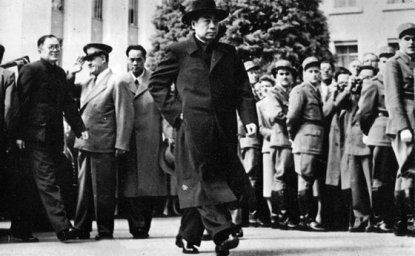Explaining North Korean Migration to China




A bridge over the Tumen River connecting China and North Korea. Image via Wikimedia Commons.
NKIDP e-Dossier no. 11, "Explaining North Korean Migration to China," is introduced by Hazel Smith and features 11 translated Chinese documents which provide a window into historical cases of legal and illegal migration between the DPRK and China.
***
Explaining North Korean Migration to China
by Hazel Smith
The North Korea/China border region is often portrayed as a place of recent North Korean migration that started in the wake of famine of the early 1990s and which accelerated as poverty and economic hardships became a permanent feature of the North Korean economic landscape. This common knowledge is, however, only partially true and obscures as much as it illuminates: It ignores and is ignorant of the pre-existing fluidity of legal and illegal migration between the northern DPRK and the northern provinces of China. Importantly, the dominant narrative fails to understand that what was very new about the 1990s was not inter-country migration itself but the reversal of migration flow patterns. Prior to the 1990s, migration between the two countries was mainly a one-way traffic of ethnic Koreans of Chinese nationality heading south towards North Korea. Some contra-flow took place as North Korean women who had married Chinese men attempted, against North Korean government opposition, to move to China (Document No. 2) but major changes in the direction of flow did not start until the 1990s, despite some evidence of changing migrations patterns in the 1970s. In 1970 for example Chinese state authorities reminded local officials that North Koreans attempting illegally to cross the border into China should be repatriated (Document No. 11).
These documents trace internal discussions within the Chinese government about border crossers between 1957 and 1970. Also reproduced here is the 1964 agreement on border crossers between the Chinese and North Korean governments (Document No. 10). The documents are illuminating in their contribution to understanding the historical fluidity of cross-border migration, which in turn helps explain why border crossing to China was understood as a viable option for North Koreans in the early 1990s. The pull and push factors shaping North Koreans’ decision-making were that China’s economy developed exponentially at the same time as North Korea’s economy tanked. These documents show, however, that cross-border migration was already a familiar coping strategy for Koreans living in the China/DPRK border region. The only difference in the 1990s was the direction of flow.
Ethnic Koreans of Chinese Nationality Migrate to the DPRK… in Their Droves
Ethnic Koreans of Chinese nationality left China for the DPRK in the 1950s, 1960s, and 1970s, legally and illegally, in order to escape famine, poverty and racial discrimination.[1] These documents make clear that Chinese authorities were well aware that a major reason for ethnic Koreans crossing over to North Korea from the late 1950s onwards was because of the ‘temporary economic difficulties’ facing China. As China suffered famine and terrible economic hardship, ethnic Koreans saw a North Korea that was undergoing economic growth; where they had family relations and social networks; where they could speak the language; and, most of all, where they might not be hungry. For ethnic Koreans it was not too difficult to swap one authoritarian regime for another, as in the DPRK their civic lives improved by the very fact that they did not face discrimination because of their ethnicity, which, as these documents also record, they frequently confronted in China. For its part, the North Korean government offered work and economic opportunity to in-migrating Koreans because, as detailed here, the government faced labor shortages and saw ethnic Koreans from China as helpful in filling labor gaps. These documents testify to the non-ideological motivation of both in-migrating Koreans and the North Korean government. Chinese-Koreans wanted work and food, and the North Korean government wanted workers.
Both countries agreed that they should, in principle, return illegal migrants, but prior to the formal Protocol of 9 June 1964, the Chinese government noted that not all were returned by the DPRK. Indeed, as the Chinese Ministry of Foreign Affairs complained in a May 1961 document translated here (Document No. 3), the North Korean government provided incentives for Koreans to stay in the DPRK, giving new settlers from China housing, grain, money and work on cooperative farms. Of the 28,028 persons discovered crossing the border into North Korea in 1961, over 7,000 stayed in North Korea. The Ministry of Foreign Affairs was also concerned about the high numbers of people risking their lives to cross into the DPRK, with a 24 March 1962 telegram noting that 245 corpses had been found by the Yalu and Tumen rivers in North Korea in 1961, presumably drowning while trying to cross the border (Document No. 6).
These documents show that the Chinese government took a rather sympathetic approach to the plight of ethnic Koreans in China. Legal migration was not forbidden, and at the level of policy pronouncements, the Chinese government supported improving conditions of life for ethnic Koreans living in China as well as making it easier for them to visit relatives in North Korea. A 1961 report from the Chinese Ministry of Public Security noted that border residents were “fleeing” China, but “we cannot treat the average fleeing resident as the enemy” (Document No. 4).
The 1964 Protocol
The 1964 Protocol was an attempt to differentiate between the different sorts of circumstances in which authorized and unauthorized migration took place between China and the DPRK and to regularize how the different types of border crossers should be treated by both states. The Protocol spells out how both countries should cooperate on a whole range of border issues. These include, for example, dealing with poultry and livestock straying over the border (they should be returned); assisting citizens who cross borders because of disasters such as fire, flood and, perhaps more curiously, “labor incidents”; the return of corpses washed up in the Yalu and Tumen rivers that divide the two territories; the opening times of border crossing posts; and the bureaucratic arrangements for convening meetings between the relevant authorities in both countries to monitor the agreement (Document No. 10).
Article Four states that illegal border crossers should be sent back to their country of origin with the important caveat that unless the border crosser is a “criminal,” “those forced to cross the border as a result of disaster will not be treated as illegal border crossers.” Article Five specifies that that the security apparatus of both countries should cooperate actively in apprehending border crossers who are criminals and that these criminals include counterrevolutionaries as well as “basic criminals’ (Article Five). The controversy today as to whether China should send back North Korean migrants is largely based on how China interprets and implements Articles Four and Five of the 1964 Protocol.
Implementing Articles Four and Five of the 1964 Protocol
China’s interpretation of the 1964 agreement has vacillated between leniency and stringency. It has, for example, rather generously interpreted Article Four, which specifies that illegal border crossers should be repatriated except when border crossing is as a result of “disaster.” The 50,000 or so North Koreans living illegally in China are testament to Chinese toleration of North Korean migration as are the very frequent repeat border crossings by thousands of North Koreans who have found ways to frequently cross over to China and then go back home again; hence the phenomena of some advocacy agencies referring to North Koreans having “escaped” North Korea on numerous occasions. There are very well established trading routes across the border, some of these authorized and many not, but most are unimpeded by Chinese authorities. Illegal short-term or frequent North Korean border crossers may cause irritation to Chinese and North Korean border guards, but these migrants do not on the whole risk serious penalties. The Chinese government has also shown a generous interpretation of Article Four by regularizing the civil status of children born to Chinese nationals and illegal North Korean migrants, granting them the essential hukou (household registration) so they are neither stateless nor denied access to social services and education. One of the reasons it has tolerated economic border crossing for work and food is because North Korean adults have been prepared to take up low-paying jobs in agriculture and forestry that have not been attractive to local residents, many of whom are highly educated and who are more interested in working in booming cities in the border area, such as Yanji City, which is the recipient of very large South Korean investment.
On the other hand, both China and the DPRK are stringent in the application of Article Five if they consider that migrants are involved with “criminal” in the sense of “counter-revolutionary activity.” This means that North Koreans who develop relationships with South Korean bodies like churches and advocacy organizations, particularly those that are designed to overthrow the North Korean government, have a hard time of it if they are deported back to the DPRK. It also means that when China considered the North Korean migrant community as becoming politicized at the time of the foreign-organized “invasions” of foreign embassies in the early 2000s, it responded by severely implementing the provisions of the Protocol, rounding up and sending hundreds of North Koreans who had previously lived illegally but relatively securely in China, some for several years.
Explaining North Korean Migration to China in the 1990s
This set of documents helps us understand the significance of ethnic identification for Koreans living in the northern part of the DPRK and China and, also, the pragmatic motivations underpinning Korean migration in and out of China from the 1950s onwards. These documents also show that, for China, as these documents frankly acknowledge, ethnic Korean migration to the DPRK was worrisome, not for the sake of the issue itself, but because the direction of flow out of China towards an ethnic ‘homeland’ might serve as encouragement to other ethnic minorities in China (Document No. 3). Finally, the documents demonstrate Chinese government attempts to achieve a workable policy towards Korean border crossers as well as a disposition to accommodate the concerns and imperatives of the North Korean government.
***
Hazel Smith is Professor in Humanitarianism and Security at Cranfield University UK and a Fellow at the Woodrow Wilson Center. She received her PhD in International Relations from the London School of Economics in 1992. Professor Smith was a Fulbright scholar and visiting fellow at Stanford University in 1994/95; and from 2001/2002 was based in Washington DC as Jennings Randolph Visiting Senior Fellow at the United States Institute of Peace. She was located at the United Nations University in Tokyo from April 2002 to August 2004.
Professor Smith has worked, published and broadcast extensively and internationally on the DPRK for 25 years—where she has been a regular visitor since 1990. Professor Smith lived for two years in the DPRK between 1998 and 2001, working for UNICEF, the UN World Food Programme, UNDP and NGOs. Professor Smith's books on North Korea include Reconstituting Korean Security: A Policy Primer (2007); Hungry for Peace: International Security, Humanitarian Assistance and Social Change in the DPRK (2005); and North Korea in the New World Order (1996). Professor Smith is currently completing a book for Cambridge University Press entitled “North Korea in Transition: History, Economics, Politics, Society.” Professor Smith is a regular broadcaster for the BBC and other international media on North Korea. Professor Smith is also the proud owner of a North Korean driving license, after passing her driving test in Pyongyang in 2001.
[1] For more details see Hazel Smith, “Asymmetric Nuisance Value: The Border in China-Democratic People’s Republic of Korea Relations,” in Uneasy Allies: Fifty Years of China-North Korea Relations, ed. Timothy Hildebrandt (Washington, DC: Woodrow Wilson Center Asia Program Special Report, September 2003): 18-25; Hazel Smith, “North Koreans in China: Defining the Problems and Offering Some Solutions,” in Crossing National Borders: Human Migration Issues in Northeast Asia, ed. Tsuneo Akaha and Anna Vassilieva (Tokyo: United Nations Press, 2005): 165-190.
All documents included in this collection were obtained for NKIDP by Zhihua Shen, former Wilson Center public policy scholar and director of the Center for Cold War International History Studies at East China Normal University.
***
DOCUMENT LIST
(click document title to be redirected to the Wilson Center Digital Archive)
Author

Professorial Research Associate in Korean Studies School of Oriental and African Studies, University of London, United Kingdom and Professor Emerita of International Security, Cranfield University, UK.

North Korea International Documentation Project
The North Korea International Documentation Project serves as an informational clearinghouse on North Korea for the scholarly and policymaking communities, disseminating documents on the DPRK from its former communist allies that provide valuable insight into the actions and nature of the North Korean state. Read more


Cold War International History Project
The Cold War International History Project supports the full and prompt release of historical materials by governments on all sides of the Cold War. Read more


History and Public Policy Program
A leader in making key foreign policy records accessible and fostering informed scholarship, analysis, and discussion on international affairs, past and present. Read more

Explore More
Browse Insights & Analysis
China and the Post-War Reconstruction of North Korea, 1953-1961

